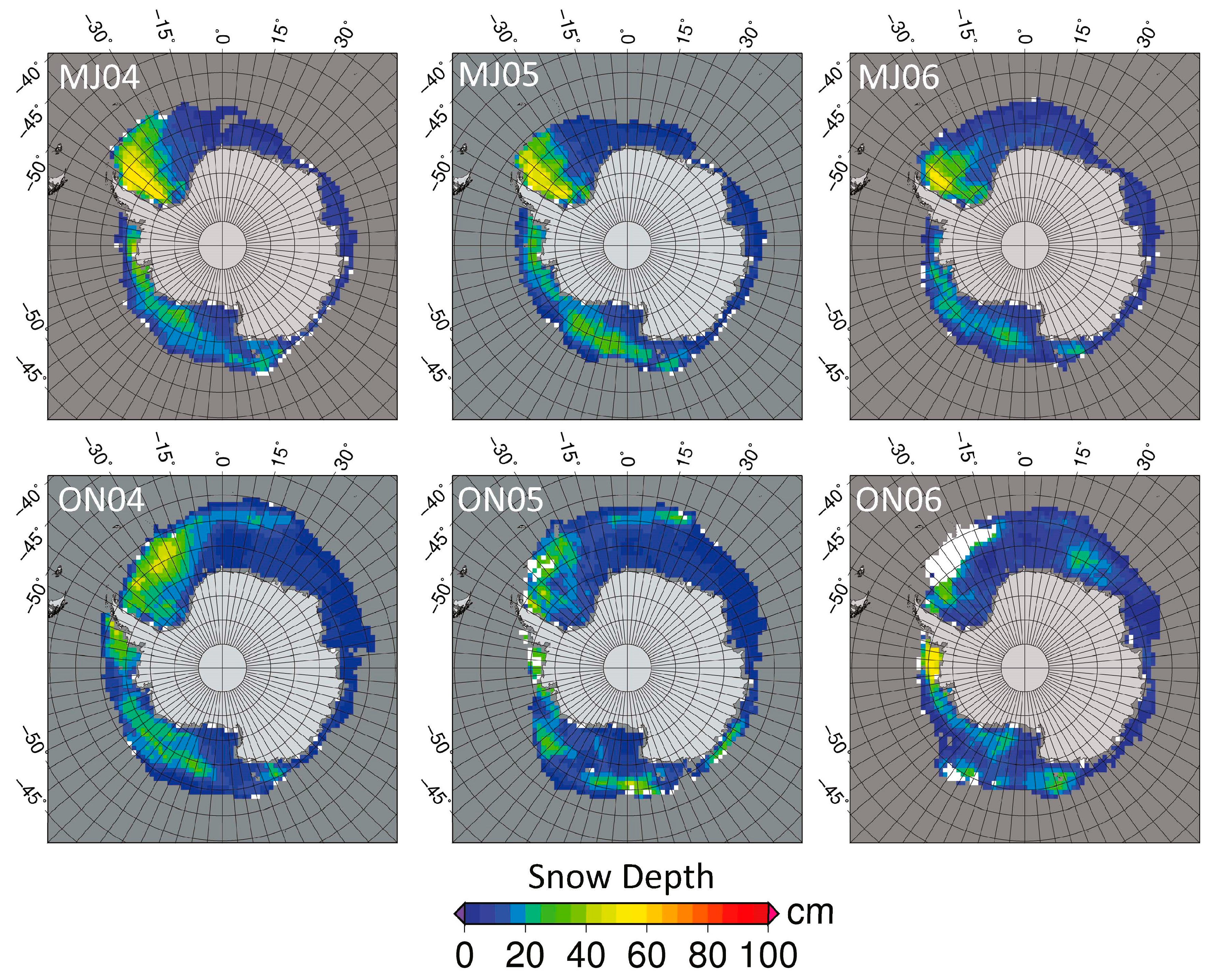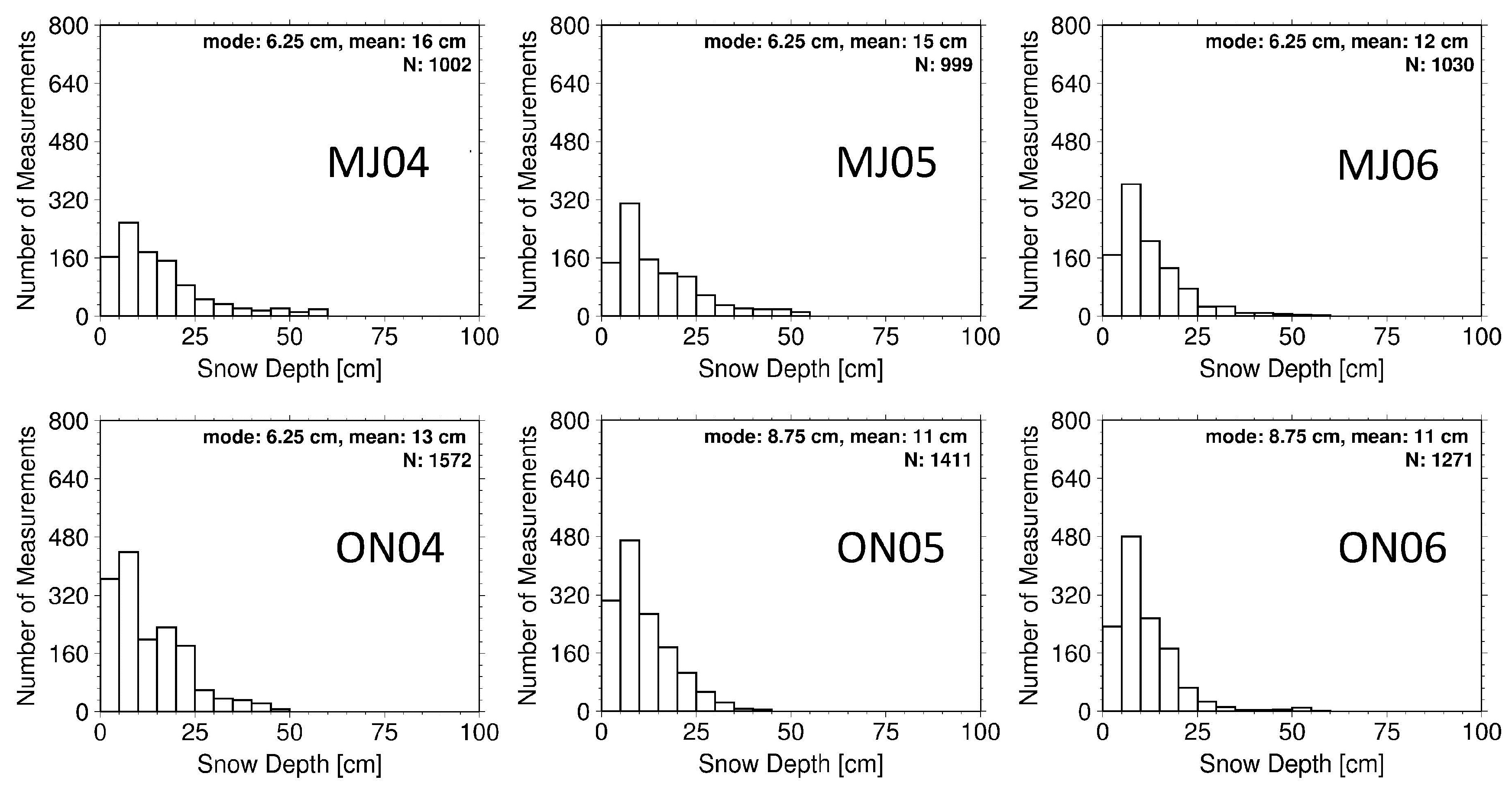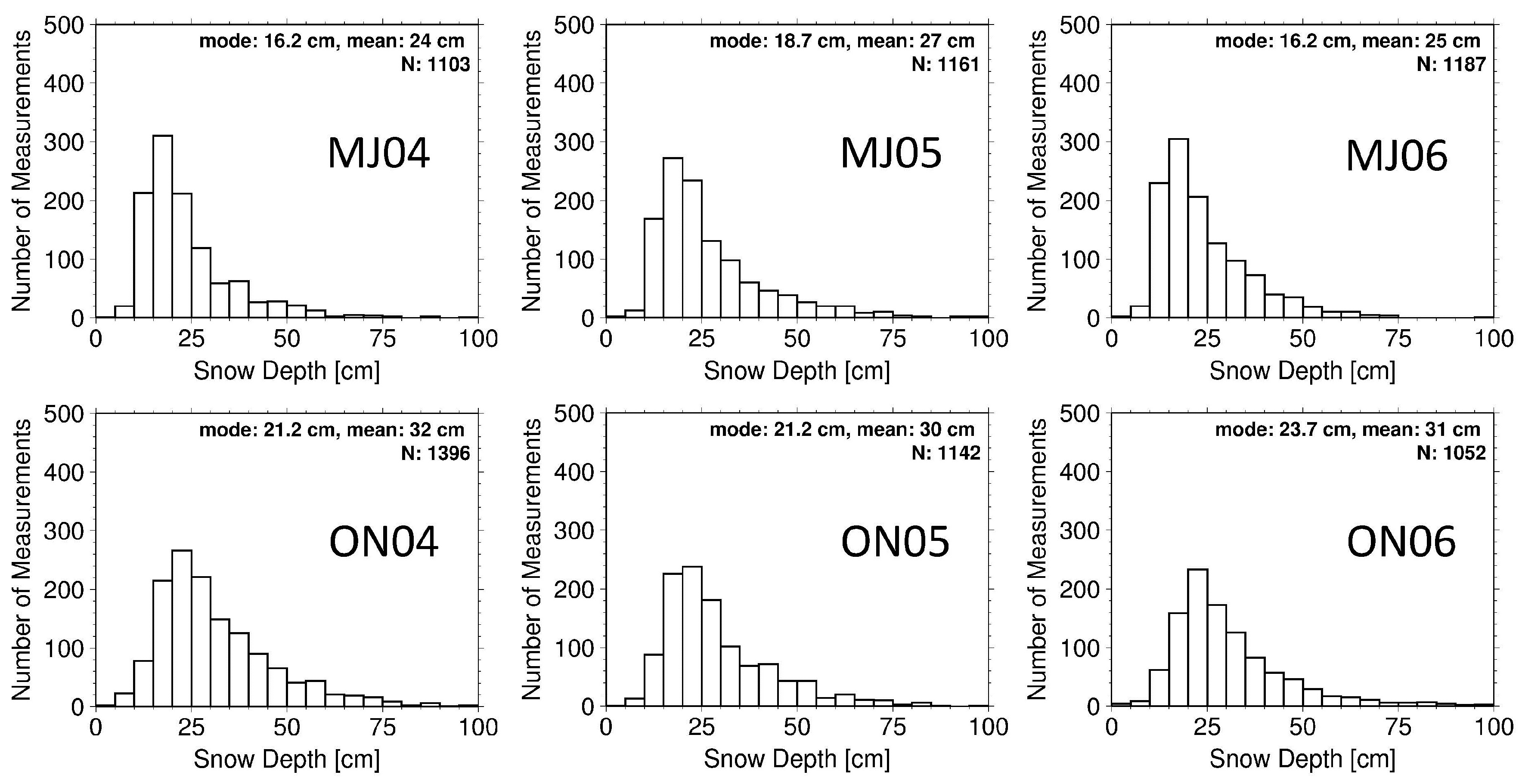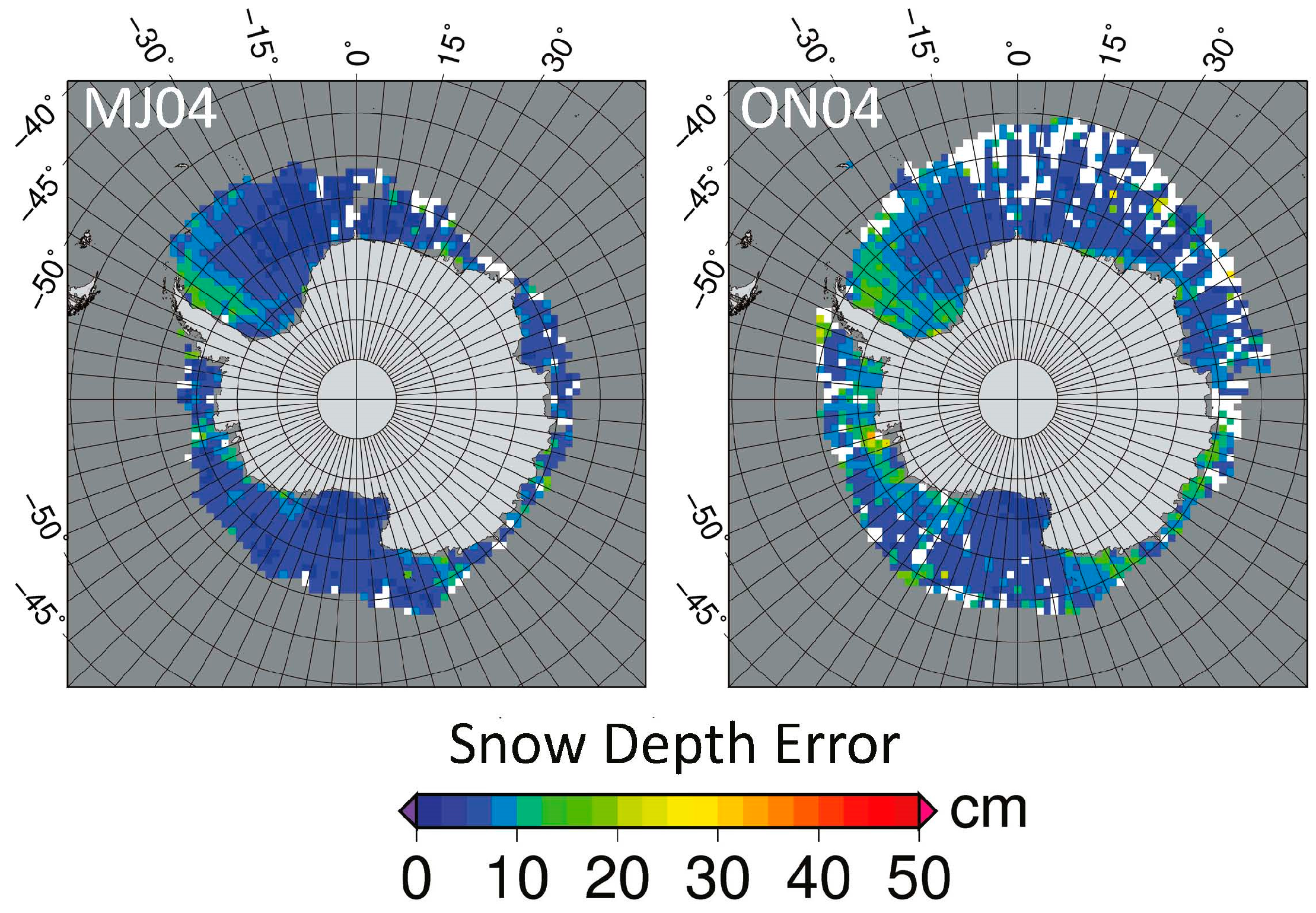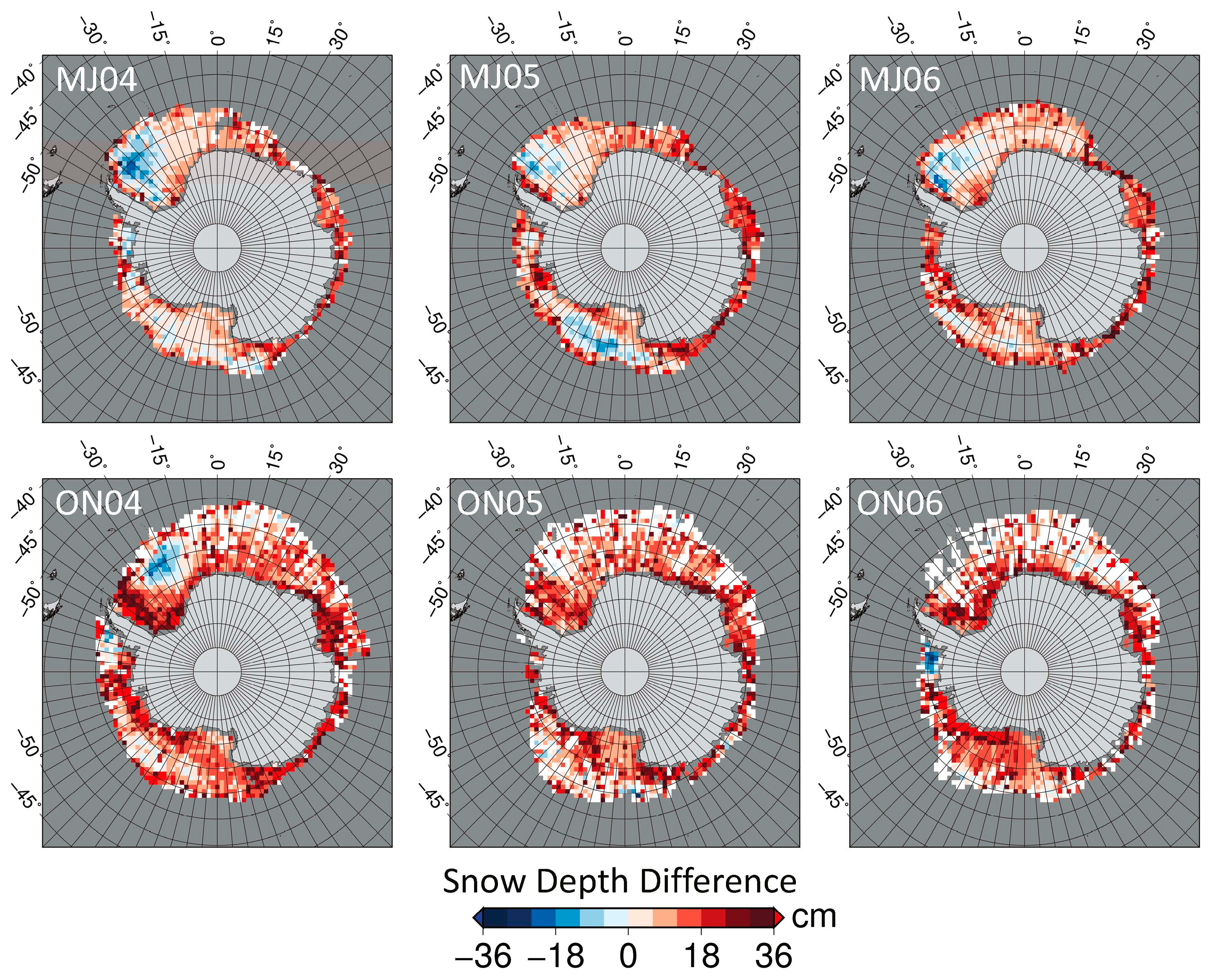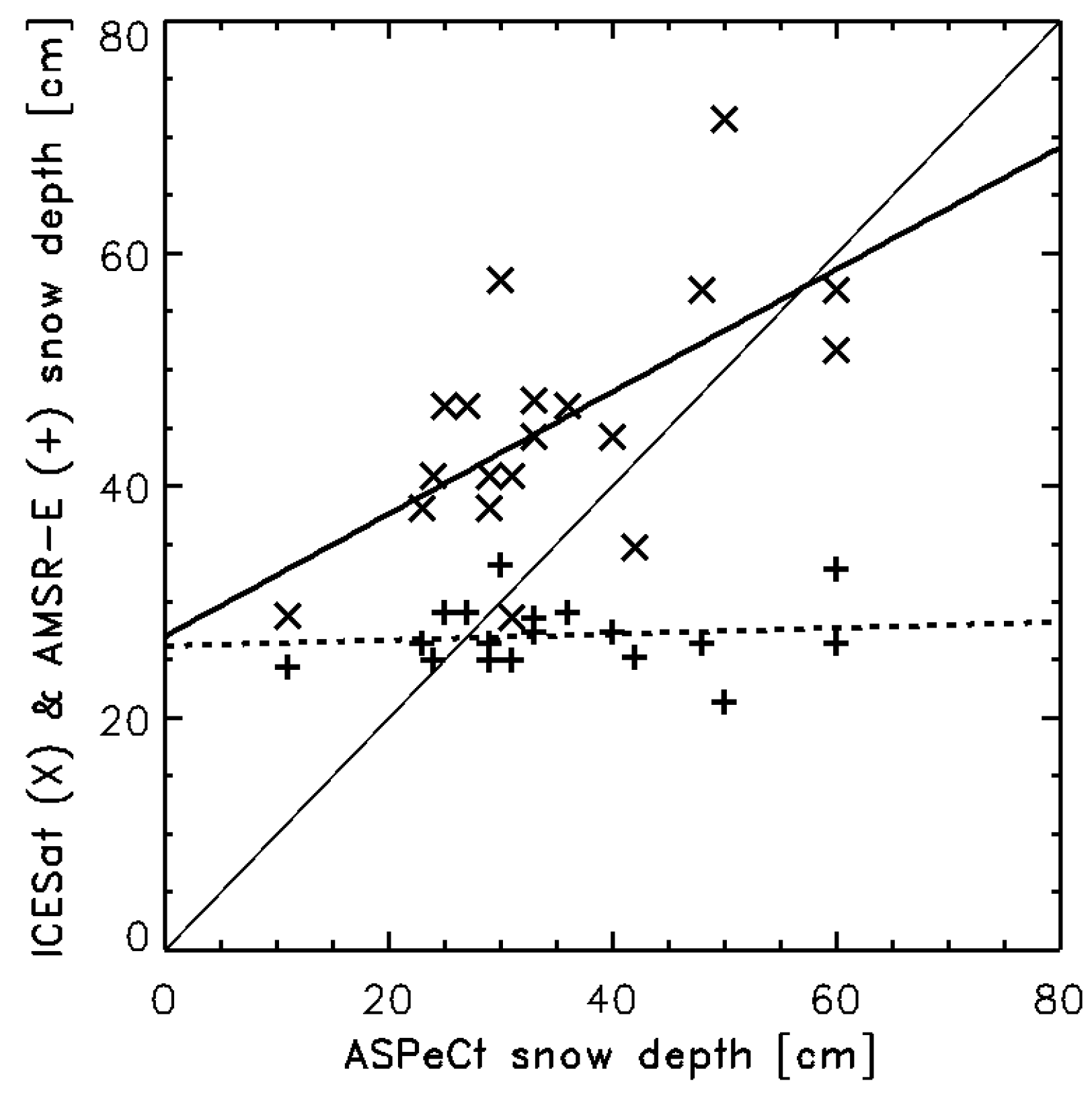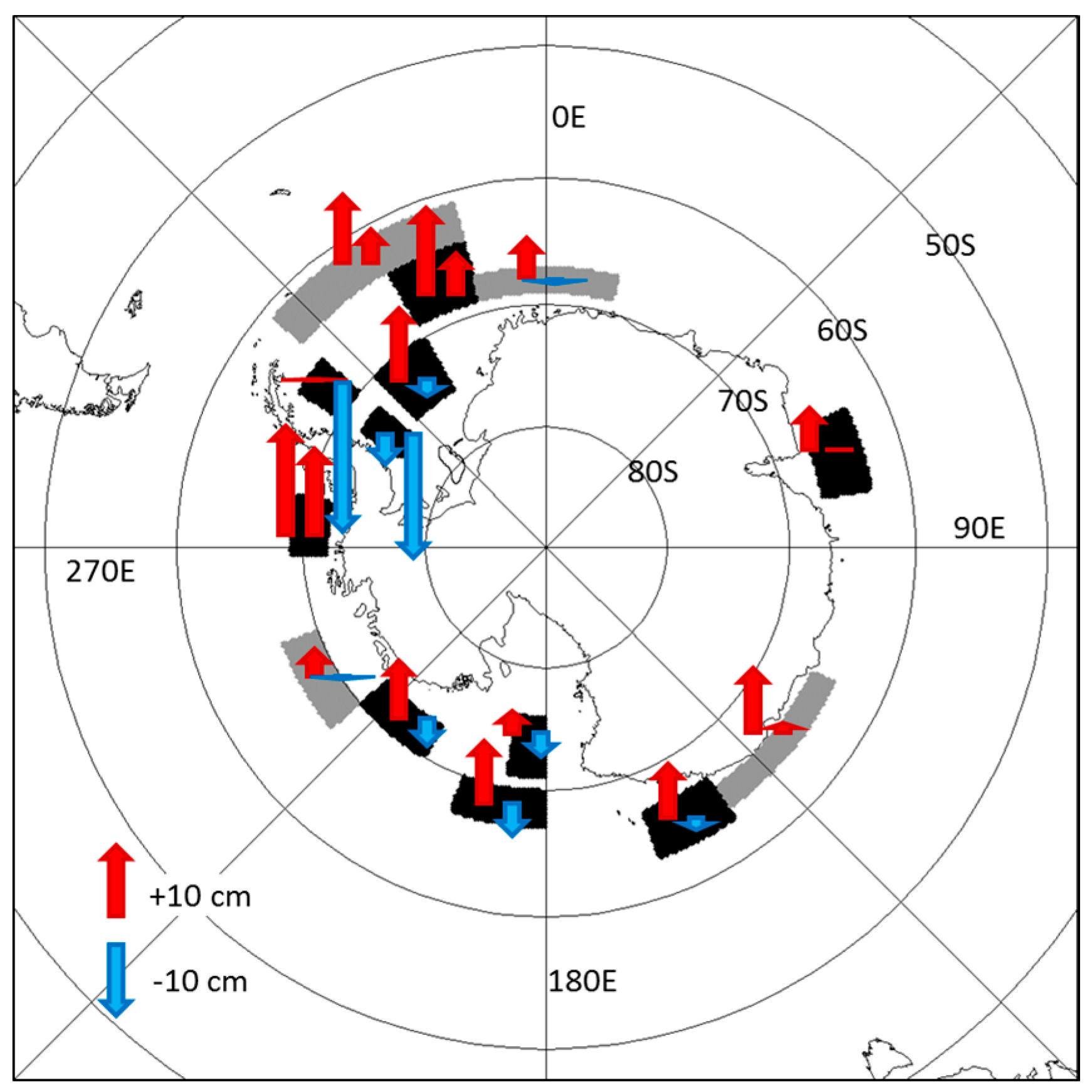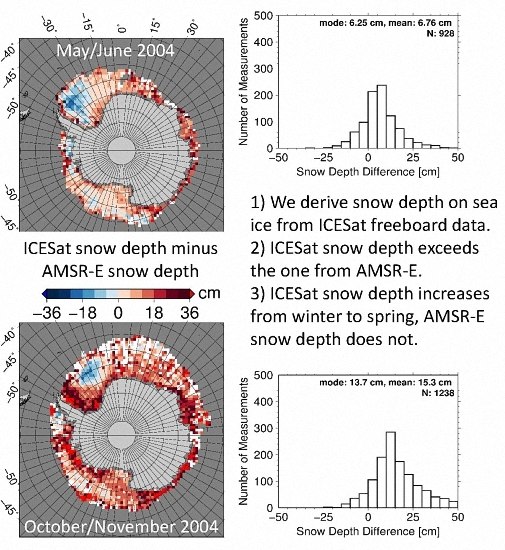In this section, we discuss qualitatively the results presented in the previous section. We note that our ICESat snow depth product is not validated. We first briefly discuss results from qualitative inter-comparisons of our ICESat snow depth with ASPeCt observations [
35] and with Operation Ice Bridge (OIB) data [
19]. We continue with a discussion about the consistency of the snow depth evolution between winter and spring. We give an overview of the sub-regions used in
Section 4.2 and
Section 4.3 in
Figure 9. We chose the location of these sub-regions such that the influence of open water is minimal and that the coverage with valid ICESat snow depth data is maximal.
For the comparison with the ASPeCt observations (
Section 4.1), we use ICESat snow depth retrieved at 25 km grid resolution. The main reason for this is that we can co-locate the ASPeCt observations with the gridded ICESat snow depth data at the finer grid resolution more accurately. We carried out an inter-comparison between ICESat snow depth obtained at 100 km and at 25 km grid resolution (not shown). The modal and the mean snow depths obtained for both, winter and spring, differ by less than 1 cm. The snow depth distribution histograms are very similar and mainly differ in a smoother tailing off of the number of measurements per bin towards larger snow depths.
4.1. Inter-Comparison with ASPeCt Visual Ship-Based Snow Depth Observations
Available in-situ observations of snow depth on sea ice from expeditions into the Weddell or Bellingshausen Sea or East Antarctic sea ice region either took place too early or too late to have temporal overlap with the ICESat measurement periods.
A comparison with ASPeCt observations carried out during the expedition SIMBA (24 September until 27 October 2007) [
28,
29] revealed AMSR-E snow depths of 25 cm to 35 cm south of 70°S, while ASPeCt snow depths ranged between 45 cm and 55 cm in the same area. For the ICESat period with temporal overlap: ON07 (see
Table 1), our ICESat snow depths are 40 cm to 50 cm in the SIMBA area. Our ICESat snow depths therefore agree more closely with ASPeCt snow depths than AMSR-E snow depths.
The expedition WWOS ended a week before period ON06 started. In addition, WWOS took place in the region where many AMSR-E snow depth data are flagged as being influenced by wet snow and/or melt–refreeze cycles (see
Figure 1, bottom, ON06). A comparison of our results with WWOS ASPeCt data does not seem meaningful therefore.
The expedition ISPOL took place a week after period ON04 ended but within two weeks the ice station was reached so that the time difference between ASPeCt observations from ISPOL and ICESat observations during the period ON04 is only 1–3 weeks. We therefore can carry out a qualitative inter-comparison between space-borne snow depth observations of ON04 and ASPeCt snow depth observations from ISPOL. For this purpose, we co-locate the ASPeCt observations to those satellite data 25 km resolution grid cells that have the smallest difference between grid cell center and ASPeCt observation location. We use only ASPeCt observations, which are separated from each other by at least 3 km to avoid giving too much weight to observations when the ship was on station or stuck in ice for several hours. We use only ASPeCt observations with a total sea ice concentration >90%. We treat ASPeCt observations with a snow depth larger or smaller than the mean ASPeCt snow depth plus or minus two standard deviations as outliers; this caused two values to be discarded from our analysis. The results are shown in
Figure 10. The range of snow depths obtained from ICESat (25 cm to 70 cm) agrees substantially better with the one from ASPeCt (10 cm to 60 cm) than with the one from AMSR-E (22 cm to 34 cm). ICESat snow depths seem to be positively biased, particularly for smaller snow depths. However, ASPeCt observations of snow depth have a limited representativity and are potentially biased low as has been detailed in
Section 2.1. By no means, these can be regarded as the truth and our results have to be interpreted carefully, as we also underline in the last paragraph of
Section 4.1.
We include linear regression lines into
Figure 10. These are meant to underline the general distribution of the data pairs rather than to suggest a linear relationship between the data sets. The latter would require a similar statistical distribution of the data sets, which we doubt is the case. On the one hand, ASPeCt observations are representative for a much smaller area (2 km times about 4 km) than the satellite data (grid resolution: 25 km × 25 km). On the other hand, ASPeCt observations miss the deeper snow on deformed sea ice and on very thick sea ice (see
Section 2.1). We note also, that the satellite data represent the average snow depth of the entire period ON04,
i.e., 35 days (see
Table 1), while ASPeCt data (ideally) have hourly temporal resolution. In other words, we assume that the snow depth distribution remains constant over our investigation period. This is a severe constraint and underlines why we only carry out a qualitative inter-comparison, why we focus on the range of snow depths encountered, and why a discussion of the different spatial scales involved can be omitted.
4.2. Inter-Comparison with OIB Snow Depth Observations
Snow depth on Antarctic sea ice was estimated from air-borne snow radar measurements carried out during OIB flight campaigns in the Weddell and Bellingshausen Sea in October 2010 and 2011 [
19]. The OIB snow radar is capable to provide an estimate of the snow depth on sea ice by measuring the distance between the supposedly strong reflection of the radar waves at the ice–snow interface and the reflection of the radar waves at the snow surface. The effective range resolution is between 6 cm and 7 cm [
19]. The accuracy is between 3.5 cm and 5 cm for a snow depth range from 10 cm to 70 cm [
19]. Strong density and/or grain size gradients in the snow, a flooded ice–snow interface and strongly deformed sea ice limit OIB snow depth retrieval. The finite range resolution leads to an under-sampling of thin snow. The bias due to this under-sampling is reported to be 5 cm to 8 cm for the Antarctic flights used here [
19]. These values are of the same magnitude as those reported by [
40] for the Arctic. Despite these limitations, the OIB observations provide us with very valuable information about the snow depth distribution along the flight tracks. We note, however, that OIB data were acquired in different years. Therefore our inter-comparison can only be a qualitative one.
For repeat track flights in the Weddell Sea, going basically from the tip of the Antarctic Peninsula to Cap Norvegia and back, [
19] found along-track averaged snow depths between 27 cm and 41 cm, and 23 cm and 51 cm in late October of years 2010 and 2011, respectively. For tracks in the southern Bellingshausen Sea snow depths range between 26 cm and 74 cm in late October 2010 and between 28 cm and 63 cm in late October 2011. The track length was ~500 km. Even though these OIB observations were carried out after the ICESat lifetime we can check whether snow depth observations from the two empirical approaches used in the present paper fall into the range given by the OIB observations. We computed the mean AMSR-E and ICESat snow depth for all four spring periods (see
Table 1) for regions “Belling” and “West” shown in
Figure 9. The results are summarized in
Table 4 and
Table 5.
For region Bellingshausen Sea (see “Belling” in
Figure 9), we find that the mean ICESat snow depth exceeds the mean AMSR-E snow depth by 15 cm to 20 cm. For three of the four years, ICESat snow depths fit better into the above-mentioned range of OIB snow depths than AMSR-E snow depths (
Table 4). For ON04 and ON07, the mean AMSR-E snow depth even falls completely out of the OIB snow depth range. For ON06, however, the mean AMSR-E snow depth exceeds the mean ICESat snow depth by 16 cm and hence fits better into the OIB snow depth range. For region Weddell Sea (see “West” in
Figure 9), OIB snow depths vary between 50 cm and 60 cm. Here the mean ICESat snow depth exceeds the mean AMSR-E snow depth by between 17 cm (ON07) and 34 cm (ON04). For all four ON period, the mean ICESat snow depth fits better into the OIB snow depth range than AMSR-E snow depths do (
Table 5). Mean AMSR-E snow depths are about 20 cm to 30 cm smaller than OIB snow depths.
Even though the OIB snow depth estimates used here are from different years and have not yet been validated [
19], these data suggest that snow depth on sea ice observed by AMSR-E is under-estimated in the two regions considered, and that the snow depth derived with our empirical approach from ICESat total freeboard agrees better with OIB snow depths.
4.3. Consistency Check: Winter to Spring Snow Depth Evolution
The lack of sufficient independent validation data for the ICESat lifetime motivated us to search for alternative measures of quality or consistency of our ICESat snow depth estimates. One such measure is the evolution of the snow depth from winter to spring. We computed the average snow depth for each region shown in
Figure 9. For ICESat and AMSR-E, we derived the average winter and average spring snow depth using data from years 2004 to 2006; only for these three years ICESat data exist for both seasons. Subsequently, we subtract the winter snow depth from the spring snow depth and visualize the resulting difference by upward red (snow depth increase) and downward blue (snow depth decrease) arrows in
Figure 11.
All regions show an increase in ICESat snow depth from winter to spring by at least 3 cm, with two exceptions: regions “Southwest” and “West” (see
Figure 9). In region “West”, ICESat snow depths stay constant, and in region “Southwest”, ICESat snow depth decreases by about 3 cm. In contrast, AMSR-E snow depth decreases by 3 cm or more from winter to spring in 7 of the 15 regions (
Figure 11). This decrease is largest (~20 cm) in those two regions where ICESat snow depth does not increase. Of the remaining 8 regions, two have an AMSR-E snow depth increase from winter to spring, which is at least half the one observed by ICESat: Regions “Central” and “Northwest” (see
Figure 9). Only region “Belling” reveals an increase in AMSR-E snow depth comparable to that of ICESat snow depth. Region “Belling” reveals the largest snow depth increase from winter to spring in both data sets. This agrees with the finding that the Antarctic Peninsula and western Antarctic receives large amounts of precipitation year round [
8,
41].
Can we explain the decrease in snow depth in regions “Southwest” and “West”? In these regions perennial ice is drifting north- and later-on northwestward. It is replaced by younger, thinner seasonal sea ice. This seasonal sea ice either originates from the Filchner-Ronne Ice Shelf polynya or from the regions further east: “SouthCentral” and “EasternCoastal” (see
Figure 9). Perennial ice usually has a thicker snow cover than seasonal sea ice because the snow can accumulate on it for a longer time period. The replacement of the old by the younger ice in regions “Southwest” and “West” can explain a decrease in snow depth from winter to spring. Whether this decrease can be as large as 20 cm, as suggested by AMSR-E, remains to be investigated. However, we would expect that a change in snow depth caused by ice drift would influence the average regional snow depth similarly in both products.
AMSR-E snow depth is known to be relatively accurate for undeformed sea ice while snow depths are underestimated by up to a factor of 2 over deformed (rough) sea ice [
27,
28,
29,
30]. It was shown by [
30] that combining AMSR-E brightness temperature observations with surface roughness information can lead to a substantial reduction in the AMSR-E snow depth bias over rough sea ice. In contrast, ICESat senses the snow surface and allows us to retrieve the snow depth independent from the ice surface roughness. Therefore, an increase in snow depth caused by more snow accumulation over deformed sea ice can most likely be identified in the ICESat snow depth data but it is less likely, that this increase can be identified in the AMSR-E snow depth data. We hypothesize that snow depth under-estimation by AMSR-E due to sea-ice deformation processes is one of the main factors contributing to the different evolution of the retrieved snow depth between winter and spring.
Snow-ice formation is another important factor that needs to be included when discussing the evolution of the snow depth from winter to spring [
3,
8]. Snow-ice formation is a three-step process. Step I: Snow accumulates on sea ice. Snow depth and total freeboard increase. Step II: The snow load suppresses the ice–snow interface below the sea surface. Seawater enters the ice–snow interface and the basal snow layer becomes wet. Snow depth and total freeboard evolution during this stage is uncertain as it depends on various environmental factors. Stage III: Under freezing conditions, the wet basal snow layer refreezes and becomes snow-ice, adding buoyancy to the sea ice and lifting it up by a few centimeters. Snow depth decreases relative to Stage I. The net change in total freeboard between Stages I and III is uncertain and depends on the amount of snow which is converted to snow-ice.
These changes in snow depth and total freeboard may be as large as several centimeters to, in extreme cases, a few ten centimeters. We hypothesize, however, that at a spatial scale of 100 km and a temporal scale of about one month, which we use, net changes in snow depth and total freeboard between the three mentioned stages are of the order of a few centimeters only. This is of the same order of magnitude as the ICESat snow depth retrieval uncertainty (see
Figure 5). AMSR-E snow depth retrieval is sensitive to snow wetness and grain size [
24]. Both parameters vary during snow-ice formation events and hence add noise to the snow depth retrieved from AMSR-E, making the estimates less accurate.
In-situ observations suggest snow-ice fractions in sea ice cores of between 10 cm and 30 cm (Table 1 in [
8]). Could repeated snow-ice formation events therefore result in a bias in the estimated snow depth because of the increase in the sea ice freeboard? Most likely this is not the case, because snow-ice formation events alternate with phases of snow accumulation during which the sea ice freeboard reduces again. This is supported by the compilation of
in-situ observations by (Table 3 in [
6]), which reveals average sea ice freeboard values of −1 cm to 5 cm.
ASPeCt observations suggest an increase in the circum-Antarctic average snow depth from 11 cm in winter to 15 cm in spring,
i.e., by ~5 cm [
23]. We find that the increase in the average modal ICESat snow depth between winter and spring of years 2004 to 2006 fits well with the above-mentioned increase in ASPeCt snow depth. In contrast, the average modal AMSR-E snow depth does not increase from winter to spring (see discussion of
Figure 3 and
Figure 4) as does the average mean AMSR-E snow depth. Snow depth observations on fast ice near Neumayer Station in Atka Bay support the increase in snow depth from winter to spring: The average snow depth increases 0–10 cm, 10–25 cm, and 30–50 cm in May/June to 20–80 cm, 70–100 cm, and ~120 cm in October/November for years 2010, 2011, and 2013, respectively [
42,
43,
44]. This corresponds to an average increase of ~50 cm. This is between about five to ten times more than what we obtain from ICESat and AMSR-E for the adjacent regions “CentralCoastal” and “Central” (see
Figure 9) for years 2004 to 2006: 5 cm and 0 cm, and 10 cm and 5 cm, respectively (
Figure 11). However, the difference in the magnitude of the observed snow depth increase can—in our opinion—be easily explained with the environmental conditions relevant for snow accumulation, which differ between drifting sea ice off the coast and fast ice close to the coast, and which include processes such as blowing snow, orographic enhancement of precipitation, snow-ice formation, and deformation.
